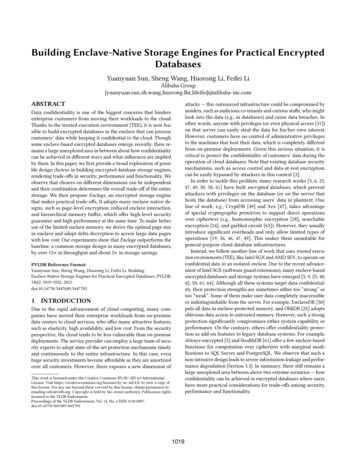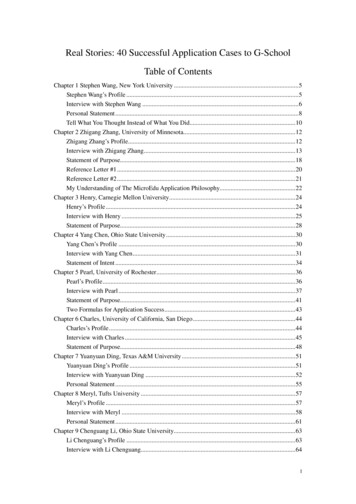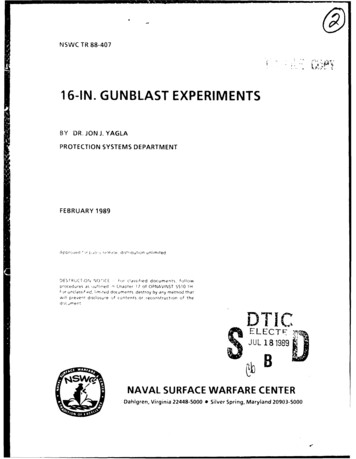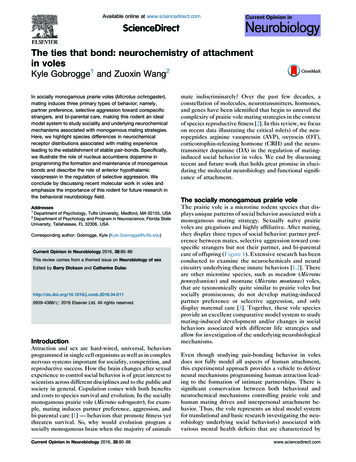
Transcription
Available online at www.sciencedirect.comScienceDirectThe ties that bond: neurochemistry of attachmentin volesKyle Gobrogge1 and Zuoxin Wang2In socially monogamous prairie voles (Microtus ochrogaster),mating induces three primary types of behavior; namely,partner preference, selective aggression toward conspecificstrangers, and bi-parental care, making this rodent an idealmodel system to study sociality and underlying neurochemicalmechanisms associated with monogamous mating strategies.Here, we highlight species differences in neurochemicalreceptor distributions associated with mating experienceleading to the establishment of stable pair-bonds. Specifically,we illustrate the role of nucleus accumbens dopamine inprogramming the formation and maintenance of monogamousbonds and describe the role of anterior hypothalamicvasopressin in the regulation of selective aggression. Weconclude by discussing recent molecular work in voles andemphasize the importance of this rodent for future research inthe behavioral neurobiology field.mate indiscriminately? Over the past few decades, aconstellation of molecules, neurotransmitters, hormones,and genes have been identified that begin to unravel thecomplexity of prairie vole mating strategies in the contextof species reproductive fitness [2]. In this review, we focuson recent data illustrating the critical role(s) of the neuropeptides arginine vasopressin (AVP), oxytocin (OT),corticotrophin-releasing hormone (CRH) and the neurotransmitter dopamine (DA) in the regulation of matinginduced social behavior in voles. We end by discussingrecent and future work that holds great promise in elucidating the molecular neurobiology and functional significance of attachment.Addresses1Department of Psychology, Tufts University, Medford, MA 02155, USA2Department of Psychology and Program in Neuroscience, Florida StateUniversity, Tallahassee, FL 32306, USAIntroductionThe prairie vole is a microtine rodent species that displays unique patterns of social behavior associated with amonogamous mating strategy. Sexually naı̈ve prairievoles are gregarious and highly affiliative. After mating,they display three types of social behavior: partner preference between mates, selective aggression toward conspecific strangers but not their partner, and bi-parentalcare of offspring (Figure 1). Extensive research has beenconducted to examine the neurochemicals and neuralcircuitry underlying these innate behaviors [1,2]. Thereare other microtine species, such as meadow (Microtuspennsylvanicus) and montane (Microtus montanus) voles,that are taxonomically quite similar to prairie voles butsocially promiscuous, do not develop mating-inducedpartner preference or selective aggression, and onlydisplay maternal care [3]. Together, these vole speciesprovide an excellent comparative model system to studymating-induced development and/or changes in socialbehaviors associated with different life strategies andallow for investigation of the underlying neurobiologicalmechanisms.Attraction and sex are hard-wired, universal, behaviorsprogrammed in single cell organisms as well as in complexnervous systems important for sociality, competition, andreproductive success. How the brain changes after sexualexperience to control social behavior is of great interest toscientists across different disciplines and to the public andsociety in general. Copulation comes with both benefitsand costs to species survival and evolution. In the sociallymonogamous prairie vole (Microtus ochrogaster), for example, mating induces partner preference, aggression, andbi-parental care [1] — behaviors that promote fitness yetthreaten survival. So, why would evolution program asocially monogamous brain when the majority of animalsEven though studying pair-bonding behavior in volesdoes not fully model all aspects of human attachment,this experimental approach provides a vehicle to deliverneural mechanisms programming human attraction leading to the formation of intimate partnerships. There issignificant conservation between both behavioral andneurochemical mechanisms controlling prairie vole andhuman mating drives and interpersonal attachment behavior. Thus, the vole represents an ideal model systemfor translational and basic research investigating the neurobiology underlying social behavior(s) associated withvarious mental health deficits that are characterized byCorresponding author: Gobrogge, Kyle (Kyle.Gobrogge@tufts.edu)Current Opinion in Neurobiology 2016, 38:80–88This review comes from a themed issue on Neurobiology of sexEdited by Barry Dickson and Catherine 959-4388/# 2016 Elsevier Ltd. All rights reserved.Current Opinion in Neurobiology 2016, 38:80–88The socially monogamous prairie volewww.sciencedirect.com
Neurochemistry of attachment Gobrogge and Wang 81Figure 1100(b)Contact Time (min/3hr)(a)PartnerStranger80*60402006 h anger StrangerFemaleMale(f)Time in natal nest (sec/30min)(e)24 h Mating(d)Aggression (# attacks /10min)(c)8006004002000FemaleMaleCurrent Opinion in NeurobiologyLaboratory characterization of mating-induced pair-bonding behavior. (a) Photo depicts a pair-bonded male and female prairie vole displayingside-by-side (cuddling) contact (Photo by C. Badland & A. Smith). (b) In male and female prairie voles, 6 h of social cohabitation, without mating,is not sufficient to induce partner preference, as voles spend approximately an equal amount of contact time with their partner or with a stranger.Conversely, 24 h of cohabitation with successful copulation promotes partner preference formation, as voles spend significantly more time in sideby-side contact with their partner than with an unfamiliar stranger during a 3 hr partner preference assay. (c) Photo shows a pair-bonded maleprairie vole (top) preparing to attack an unfamiliar stranger male prairie vole (bottom; Photo by C. Badland & A. Smith). (d) Sexually inexperienced(Naı̈ve) male prairie voles do not display aggressive behavior toward a stranger, although successful mating and two weeks of social cohabitationengenders escalated selective aggression toward stranger male and female conspecifics but not toward familiar female partners. (e) Photoillustrates a pair-bonded male and female prairie vole huddling over and protecting their newly born pups (Photo by C. Badland & A. Smith). (f)Male and female prairie vole parents spend equivalent time in their natal nest huddling, contacting, and licking/grooming their offspring. Barsindicate means standard error of the mean. Bars with different Greek letters differ significantly from each other. *p 0.05.Adapted from [2,32 ,40,61].www.sciencedirect.comCurrent Opinion in Neurobiology 2016, 38:80–88
82 Neurobiology of sexproblems with attachment such as those that suffer fromautism spectrum disorders.Neurochemical regulation of pair-bondingbehaviorResearch in voles has revealed a variety of neuromodulators in the regulation of mating-induced pair-bondingand comparable work in humans has implicated several ofthese same neurochemical systems. For example, thenine amino-acid (nonapeptide) AVP has been implicatedin human aggressive behavior, as higher levels of AVPassayed from cerebrospinal fluid taken from aggressivepatients has been shown to be associated with a history ofviolent behavior in both men and women [4]. Furthermore, a structurally similar nonapeptide, OT, administered intra-nasally in human couples, significantlyenhanced several dimensions of positive communicationbetween one-another such as agreeableness, positiveregard for the self and partner, consolation, and increasedeye-contact during a simulated couple’s quarrel as well assignificantly reduced salivary cortisol levels after a seminaturalistic conflict [5]. Another important element ofprosocial behavior, prerequisite for social affiliation, istrust. Trust is necessary to social, economic, and/or political success and without it these faculties quickly disintegrate. However, at the dawn of the new millennium,next to nothing was known about the biological origins oftrust in humans. Thus, in a similar double-blind placebocontrolled set of experiments as outlined above, participants were intra-nasally administered OT and reportedremarkable increases in their level of perceived trustduring social interactions which was not a general effectof OT enhancing participants’ readiness to bear risks.Conversely, OT specifically affected an individual’s willingness to accept social risks during interpersonal interactions [6 ]. Together, these data are in line with voleresearch substantiating OT as a neurobiological hallmarkof prosocial approach behavior in gregarious animals andtrust among humans — a necessary prerequisite to socialaffiliation. Finally, recent real-time functional magneticresonance imaging research found enhanced neurotransmission in dopamine-rich brain regions, in the rightventral tegmental area (VTA) and right caudate nucleus,when participants view photographs of their life-longdeeply-loving partners but not when they saw otherfamiliar people from their life [7]. Furthermore, evenat a relatively early stage of a pair-bond, activation inthe left VTA positively correlated with facial attractiveness while activation in the right anteromedial caudatenucleus was associated with the intensity of romanticpassion in individuals recently falling ‘in love’ [8]. Thesepersistent and enduring brain activation patterns suggestthat DA-ergic reward circuits may encode the arousalcomponent of the intense ‘high’ when people are motivated to develop and maintain a life-long pair-bond,rather than representing an ephemeral emotional stateof being, fleeting rationale decision, or general sex drive,Current Opinion in Neurobiology 2016, 38:80–88per se. Taken together, these findings in humans suggestthe possibility that similar neurochemicals and psychological facets of attachment and romance that resembleelements of pair-bonding behavior in voles may extend topeople as well.Partner preference formationEvidence describing the neurobiology of human matingpreferences is mixed, primarily due to the complex natureof attraction in people and the experimental limitations ofcognitive neuroscience research. Therefore, investigatingpair-bonding behavior in voles represents a valuableanimal model system to reveal underlying neurochemicalmechanisms programming social decision-making.Neurobiological research examining voles has implicatedthe neuromodulators AVP, OT, DA, and CRH in theregulation of partner preference formation.Prior research has demonstrated that 18–24 h of mating,but not 6 h of cohabitation, reliably induces partnerpreference in both male and female prairie voles(Figure 1a,b; [3,9 ]). Such mating also leads to changesin the activity of several neuromodulators, listed above,which have been implicated in social behavior in prairievoles. Because genetically related vole species were originally shown to differ in their social life mating strategies,a comparative approach was initially used to investigateintra-species differences in social behavior and underlying neurobiology. Monogamous and promiscuous volesdiffer in the pattern of AVP-V1a receptor (V1aR) distribution in the brain, specifically in reward-related regionssuch as the ventral pallidum (VP; Figure 2), indicatingspecies differences in response to centrally released AVP(Figure 2; [10,11]). Intracerebroventricular (icv) infusionof a V1aR antagonist inhibits mating-induced partnerpreference while infusions of AVP induce this behaviorin both male and female prairie voles without mating[9 ,12]. In male prairie voles, mating enhances AVP geneexpression in the bed nucleus of the stria terminalis(BNST) yet decreases AVP-immunoreactive (ir) fiberdensity in its projection area — the lateral septum(LS), suggesting increased AVP release in this area[13,14]. Indeed, intra-LS administration of AVP inducespartner preference whereas a V1aR antagonist inhibitsmating-induced partner preference. In the VP, V1aRantagonism impairs mating-induced partner preferencewhereas over-expression of V1aR by adeno-associatedviral vector-mediated gene transfer (AAV-V1aR), in sexually naı̈ve males, facilitates partner preference. Furthermore, AAV-V1aR over-expression in the VP enhancespartner preference in promiscuous male meadow voles[15 ] and facilitates social recognition in mice [16 ].Similarly, species differences are found in the patterns ofOT receptor (OTR) distribution in the vole brain — inregions critical in the regulation of social behavior andmotivation like the medial prefrontal cortex (mPFC),www.sciencedirect.com
Neurochemistry of attachment Gobrogge and Wang 83Figure 2SociallyMonogamousSociallyPromiscuousV1aRVP(or the prelimbic cortex (PLC)) prevents mating-inducedpartner preference, and intra-NAcc OT infusion inducesthis behavior without mating [19,20]. Furthermore, AAVOTR over-expression in the NAcc facilitates partnerpreference formation in sexually naı̈ve female prairievoles, but not in female meadow voles (Figure 3;[21 ]). Finally, blocking OTRs in the LS of male prairievoles also prevents mating-induced partner preference[22].Figure 3VPSexuallyNaivePairBondedOTRmPFC, NAcc, BNSTmPFC, NAcc, BNSTV1aRNAccAHHAHD1RNAccCurrent Opinion in NeurobiologyOTRMicrotine species differences in neurotransmitter receptor distributionand social behavior. Prairie voles display a socially monogamous lifestrategy after mating and pair-bonding (left image) while Meadow andMontane voles’ exhibit socially promiscuous behavior (right image).Vasopressin V1a-type receptor (V1aR) expression in the ventralpallidum (VP) and oxytocin receptor (OTR) density in the medialprefrontal cortex (mPFC), nucleus accumbens (NAcc), and bednucleus of the stria terminalis (BNST) are both higher in sexually naı̈veprairie voles (left) while promiscuous voles have fewer endogenousV1a/OT receptors available in these brain regions (right). Speciesdifferences in neuropeptide receptor density have been shown toexplain why these systems may be involved in the evolution ofdivergent mating strategies across rodent species. Conversely,dopamine D1 receptor (D1R) expression is higher in the NAcc ofnon-monogamous voles (right) and lower in prairie voles (left). Speciesdifferences in dopamine neurotransmitter receptor density have beenshown to explain why prairie voles display mating-induced selectiveaggression while meadow voles exhibit general levels of aggressivebehavior toward conspecific animals (Illustration by C. Badland).Adapted from [19,21 ,22,26,28 ,29 ,62–64].nucleus accumbens (NAcc), and BNST (Figure 2; [17 ]).ICV OT injection induces partner preference in bothmale and female prairie voles, and this effect is blockedby infusion of an OTR antagonist [12]. In female prairievoles, OT release is increased in the NAcc during mating[18], pharmacological blockade of OTRs in the t Opinion in NeurobiologyPair-bonding-induced neuromodulator receptor plasticity and socialityin the prairie vole. Sexually naı̈ve male prairie voles (left) and pairbonded male prairie voles (right) exhibit experience-dependentchanges in neurotransmitter receptor density in select brain regionsincluding the anterior hypothalamus (AH) and nucleus accumbens(NAcc). Specifically, successful mating and pair-bondingsite-specifically enhances the density of vasopressin V1a-typereceptor (V1aR) expression in the AH and oxytocin receptor (OTR) anddopamine D1-type receptor (D1R) density in the NAcc. Thesemating-induced neuroplastic changes in receptor densities explain thebehavioral switch from general patterns of social affiliation andaggression to robust social memory and selective aggression inpair-bonded male prairie voles (Illustration by C. Badland).Adapted from [28 ,32 ,34 ,64].Current Opinion in Neurobiology 2016, 38:80–88
84 Neurobiology of sexThe mesocorticolimbic DA circuit underlies emotionalvalence to control intrinsically motivated behavioraldrives like hunger and mating [23,24]. Not surprisingly,this system has also been identified as being important inthe regulation of social memory encoding partner preference and attachment. The first series of experiments thatexamined the central role of DA and partner preferenceformation employed a behavioral pharmacologicalapproach. Peripheral (intraperitoneal (ip)) treatment ofa non-selective DA receptor (DAR) antagonist was sufficient to block mating-induced partner preference whereas treatment of a DAR agonist facilitated partnerpreference without mating [25]. Similar effects werefound by treating prairie voles with a D2R-, but notD1R-, specific antagonist/agonist, indicating that D2Ractivation is critical for partner preference formation[25]. In the NAcc of both male and female prairie voles,mating was found to induce DA release [26,27] andadministration of a non-selective DAR or D2R-specificantagonist impaired mating-induced partner preferencewhereas treatment of a non-selective DAR or D2R-specific agonist facilitated partner preference formation inthe absence of mating experience [27,28 ]. Conversely,intra-NAcc D1R activation prevented partner preferenceinduced by mating or by D2R activation [28 ]. Thisreceptor-specific DA-ergic regulation of partner preference was found to be due to the opposing effects ofD1R/D2R, via the activity of the intra-cellular cyclicadenosine monophosphate (cAMP) signaling cascadeand its conjugated G-proteins, site-specifically, withinthe rostral NAcc shell [29 ].In addition to AVP, OT, and DA, the stress neuropeptide,CRH, also plays a significant role in the regulation of pairbonding behavior. Male prairie voles treated with exogenous CRH display partner preference, without mating,which can be blocked with co-administration of a CRHreceptor antagonist. Site-specific micro-infusion of CRHin the NAcc facilitates, while CRH receptor antagonisttreatment inhibits, partner preference formation in maleprairie voles. Pair-bonding with a female also significantlyincreases CRH mRNA in the BNST of males.CRH is secreted from the paraventricular nucleus of theanterior hypothalamus (PVN) and binds to CRH receptors in the anterior pituitary which synthesizes adrenocorticotrophic hormone (ACTH). ACTH is then releasedinto the bloodstream and acts on receptors expressed onthe adrenal cortex which produces glucocorticoids, likecorticosterone (CORT), that then bind to glucocorticoidreceptors (GRs) in the brain during stress. The prairievole is glucocorticoid resistant and has approximately 5to 10-times greater basal plasma CORT, 3-times higherbasal levels of ACTH, and 10-times lower affinity for theGR-type-1 receptor relative to non-monogamous rodents.In female prairie voles, cohabitation with a male significantly reduces serum CORT levels. Furthermore, adrenalectomy or GR antagonist treatment in females isCurrent Opinion in Neurobiology 2016, 38:80–88sufficient to facilitate while CORT injections, or exposure to swim stress, prevents partner preference formation. In short, these results suggest that decreases inhypothalamic pituitary adrenal (HPA) axis activity facilitate the formation of partner preference in female prairievoles. In males, the story is completely the opposite.Adrenalectomy inhibits partner preference formationand this effect can be reversed with CORT replacement.Furthermore, males experiencing the loss of a bondedpartner exhibit significantly higher levels of circulatingCORT and adrenal gland weight, implicating the HPAaxis in partner separation.Selective aggressionAmong the neurochemicals implicated in maladaptiveforms of escalated aggression and violence in humansand laboratory animals [30], AVP and DA have beenshown to be important in the regulation of adaptive formsof agonistic behavior such as selective aggression inprairie voles. Following mating and extended cohabitation, males that are pair-bonded with a female exhibitaggression toward conspecific male and female strangersbut not toward their familiar female partner (selectiveaggression; Figure 1c,d), and this behavior is important inmaintaining established pair-bonds [31]. Selective aggression is associated with increased neuronal activation,measured by Fos-ir labeling, in several brain areas including the anterior hypothalamus (AH), LS, medial preopticarea (MPOA), BNST, and posterior dorsal medial amygdala (MeAPD; [32 ,33]). In the AH, selective aggressionis accompanied by activation of AVP expressing neuronsand increased AVP release [32 ,34 ]. Administration ofthe V1aR antagonist, icv or site-specifically into the AH,diminishes selective aggression [9 ,34 ]. Conversely,administration of AVP enhances selective aggression insexually naı̈ve males, and this AVP-facilitated aggressioncan be blocked by concurrent administration of a V1aRantagonist [9 ,34 ]. Furthermore, pair-bonded malesexhibit an increased density in V1aR binding in theAH compared to their sexually naı̈ve counterparts(Figure 3), and over-expression of V1aR in the AH, byAAV-V1aR, facilitates selective aggression in sexuallynaı̈ve males [34 ]. These data demonstrate that AHAVP is involved in the regulation of selective aggressionin male prairie voles. AH-AVP has also been shown toregulate aggression in Syrian hamsters [35]. In humanclinical studies, CSF levels of AVP are associated with alifetime history of physical violence and assault in individuals with borderline personality disorder [4] and maycontrol the perception of social cues conveying anger inresearch participants [36].The frequency and intensity of physical aggression istypically observed more in males than in females acrossmany species. Because of these sex differences, previousresearch examined the potential role of steroid hormones,like androgens, in the development of aggressive behavior.www.sciencedirect.com
Neurochemistry of attachment Gobrogge and Wang 85However, castration in male prairie voles and male rats hasno effect on aggression. Therefore, circulating testosteronecannot be the sole contributor of aggressive behavior. Forexample, AVP infused directly into the MeAPD facilitatesterritorial aggression in castrated male rats. Because the actof aggression relies heavily on motivation and emotionalvalence, these affective states are partially encoded viacentral DA.The mesocorticolimbic DA system has been implicatedin prairie vole aggression [28 ]. Two weeks of pairbonding lead to enhanced expression of D1Rs, but notD2Rs, in the rostral NAcc shell in the male prairie volebrain (Figure 3). Furthermore, male meadow voles exhibit significantly more D1-like DA receptors in the NAccthan do male prairie voles (Figure 2), providing evidenceto potentially explain why non-monogamous animalsdisplay general levels of aggression while socially monogamous species exhibit ‘jealousy’-like behavior includingpatterns of mating-induced selective aggression directedtoward other conspecifics except toward their familiarpartner (Figure 1c,d). Pharmacological blockade ofD1Rs in the NAcc reduces selective aggression in pairbonded males. In parallel drug experiments, repeated treatment of the commonly abused psychostimulant, amphetamine (d-AMPH), enhanced aggression toward conspecificfemales as well as toward a female partner which preventedpartner preference formation [34 ,37 ]. Pharmacologically, these drug-addled pair-bonding deficits can be reversedvia micro-infusion of OT in the mPFC [38 ]. Finally, thesealterations in social behavior overlap with an increase inNAcc-D1R and AH-V1aR, indicating that drugs of abusecan hijack neuroplasticity evolved to retain social fidelity[34 ,37 ].Bi-parental careAlthough the neurobiology of maternal behavior has beenextensively studied, we know virtually nothing about theneurobiology of paternal behavior, mainly due to the lackof appropriate animal models that display bi-parentalcare. Thus, prairie voles provide a unique opportunityto study the neurochemical regulation of paternal behavior. Both female as well as male prairie voles spend equalamounts of time in their natal nest providing parental carefor their offspring (Figure 1e,f). Pup exposure induces anincrease in Fos-ir in the accessory olfactory bulb (AOB),MPOA, BNST, MeAPD, and LS in male prairie, but notmeadow, voles, suggesting increased, regional neuronalactivation associated with the display of paternal behaviorin prairie voles [39,40]. When this socioemotional circuitis impaired via bulbectomy or MeAPD lesioning, paternalbehavior is dramatically decreased in male prairie voles[41,42]. After pairing with a female for two weeks orbecoming fathers, male prairie voles display higher levelsof paternal behavior associated with altered AVP activityin the brain including increased AVP mRNA expressionin the BNST and PVN [13,14] and decreased AVP-ir fiberwww.sciencedirect.comdensity in the LS [43,44]. Infusion of AVP or OT in thebrain (icv) enhances paternal behavior in sexually naı̈vemale prairie voles whereas V1aR or OTR blockadedecreases pup retrieval and huddling and increases pupattacks [45]. The LS has also been identified as a targetbrain area in which infusions of AVP enhance and a V1aRantagonist impairs paternal behavior in male prairie voles[46]. In other laboratory rodents, AVP in the LV increasesmaternal behavior in female rats [47] and in new fathermarmosets, whom also display paternal behavior, thedensity of V1aRs and dendritic spines in the mPFC issignificantly increased, compared to non-fathers [48].Because good parenting represents a critical social behavior necessary for healthy development of offspring andspecies survival, it is not surprising to also learn thatcentral DA plays a critical role in the regulation ofparental behavior. Like its role in maternal behavior[49], central DA has also been implicated in paternalbehavior. In male prairie voles, neurons that expresstyrosine hydroxylase (TH; rate limiting enzyme for DAbiosynthesis) in the BNST and MeAPD are activated bypup interaction [50]. Peripheral administration (ip) of aDAR antagonist reduces pup licking and contact yetincreases pup huddling without affecting locomotor activity in both male and female prairie voles [51 ]. DA isreleased in the NAcc of female rats exposed to pupstimuli [52] and released DA regulates maternal behaviorin a DAR-specific manner [53].The HPA axis has also been described in parental behaviorof voles. For example, swim stress experience significantlyenhances time spent huddling over and licking and grooming, pups but is not observed in unstressed male fathercontrols. Importantly, these effects on paternal behaviorare not observed in female prairie voles which suggest that,like the sexually dimorphic effects of CRH on partnerpreference formation, CRH may exert sex-specific effectson parental behavior as well. Finally, icv micro-infusion ofurocortin-II, a closely related member of the CRH neuropeptide family, significantly increased passive parentalbehavior in both male and female prairie voles, withoutaffecting locomotor or anxiety-like behaviors.Conclusions and future directionsIn humans, AVP, OT, DA, and CRH underlie many socialbehaviors including bonding, aggression, and parentalcare. These systems work in concert with one anotherto control levels of sociality. Mating in the socially monogamous prairie vole induces long-lasting neuroplasticity in circuits that regulate an enduring suite of pairbonding, mate guarding, and parental behavior. In theprairie vole, the same neuromodulators interact to produce these robust behavioral patterns after copulation.Emerging research using the prairie vole has begun toinvestigate the neurobiology of pair-bond functions suchas the role of OT on partner’s stress-buffering [54,55,56 ]Current Opinion in Neurobiology 2016, 38:80–88
86 Neurobiology of sexand consolation [57 ]. Furthermore, exciting molecularwork demonstrates epigenetic regulation of AVP and OTneuropeptidergic systems underlying mating-inducedpair-bonding [58 ]. Novel semi-naturalistic field studiesin prairie voles has found that DNA variation in the V1aRgene includes polymorphisms that predict the epigeneticstatus and neuronal expression of V1aR in a spatialmemory circuit and this genomic diversity in V1aR isfavored by selection [59 ]. Finally, our most recent datareveal neurochemical interactions between AVP, serotonin (5-HT), and CRH, in a neuronal microcircuit, encoding a male prairie vole’s decision to affiliate or fight hisfemale partner or a stranger female [60 ]. Together withprevious studies, the prairie vole field is ripe for incorporating contemporary molecular genetic tools like genomictract-tracing, opto-/chemo-genetic approaches, and geneediting via CRISPR technology. By adding these techniques to the vole toolbox, the field will be able tomolecularly target and genetically manipulate neurotransmitter systems underlying the neuroplasticity accompanied by sexual experience and the resultinginnate social drives that ensue.Conflict of interest statementNothing declared.AcknowledgementsThe authors would like to thank Dirson João Stein and the editor’s forproviding very helpful feedback on our review. The work referenced in thismanuscript was supported by National Institutes of Health grants F31MH79600 and F32-GM096591 to KLG, MHR01-58616, DAR01-19627, andDAK02-23048 to ZXW, and NIH Program Training Grant T32 NS-07437.References and recommended readingPapers of particular interest, published within the period of review,have been highlighted as: of special interest of outstanding interest1.Young LJ, Wang Z: The neurobiology of pair bonding. NatNeurosci 2004, 7:1048-1054.2.Young KA, Gobrogge KL, Liu Y, Wang Z: The neurobiology of pairbonding: insights from a socially monogamous rodent. FrontNeuroendocrinol 2011, 32:53-69.3.Insel TR, Preston S, Winslow JT: Mating in the monogamousmale: behaviora
The ties that bond: neurochemistry of attachment in 1 voles Kyle Gobrogge and Zuoxin Wang2 In socially monogamous prairie voles (Microtus ochrogaster), mating

